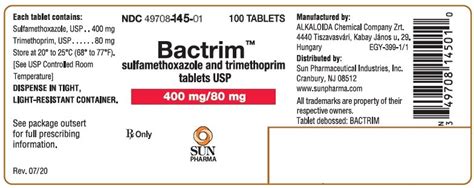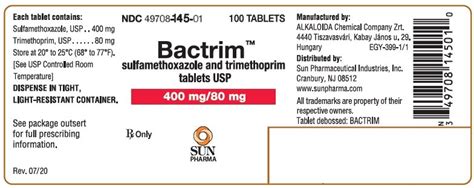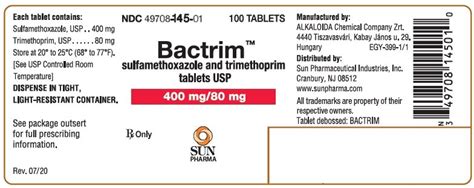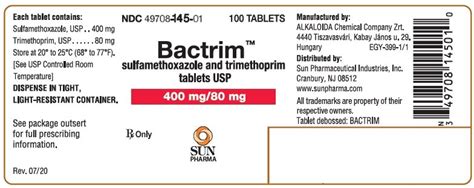Intro
Discover the Bactrim DS 800-160 antibiotic guide, exploring its uses, dosage, and side effects for treating bacterial infections, including urinary tract infections and respiratory issues, with expert advice on prescription antibiotics and medication management.
The world of antibiotics can be complex and overwhelming, especially for those who are not familiar with the various types of medications available. One such antibiotic that has gained popularity in recent years is Bactrim DS 800-160. As a widely prescribed medication, it's essential to understand its uses, benefits, and potential side effects. In this article, we'll delve into the world of Bactrim DS 800-160, exploring its mechanisms, applications, and what you need to know before taking it.
Bactrim DS 800-160 is a combination antibiotic that consists of two active ingredients: sulfamethoxazole and trimethoprim. This potent combination has been used to treat a wide range of bacterial infections, including urinary tract infections, respiratory infections, and skin infections. With its broad-spectrum activity, Bactrim DS 800-160 has become a go-to medication for many healthcare professionals.
The importance of understanding antibiotics like Bactrim DS 800-160 cannot be overstated. As antibiotic resistance continues to rise, it's crucial to use these medications responsibly and only when necessary. By doing so, we can help prevent the spread of antibiotic-resistant bacteria and ensure that these life-saving medications remain effective for years to come.
Introduction to Bactrim DS 800-160

Bactrim DS 800-160 is a type of sulfonamide antibiotic that works by inhibiting the growth and reproduction of bacteria. The medication is available in tablet form and is typically taken orally, with or without food. The "DS" in Bactrim DS 800-160 stands for "double strength," indicating that the medication contains a higher dose of the active ingredients compared to the regular strength version.
How Bactrim DS 800-160 Works
Bactrim DS 800-160 works by targeting the bacterial cell's ability to produce essential nutrients, such as folic acid. The sulfamethoxazole component of the medication competes with para-aminobenzoic acid (PABA), a natural compound found in bacteria, to inhibit the production of folic acid. Meanwhile, the trimethoprim component blocks the enzyme dihydrofolate reductase, which is necessary for the conversion of folic acid to its active form. By blocking these two essential steps, Bactrim DS 800-160 effectively prevents the growth and reproduction of bacteria, ultimately leading to their death.Benefits of Bactrim DS 800-160

Bactrim DS 800-160 offers several benefits, including:
- Broad-spectrum activity: Bactrim DS 800-160 is effective against a wide range of bacterial infections, making it a versatile medication for various conditions.
- High efficacy: The combination of sulfamethoxazole and trimethoprim in Bactrim DS 800-160 provides a synergistic effect, resulting in high efficacy against bacterial infections.
- Convenience: Bactrim DS 800-160 is available in tablet form, making it easy to take and administer.
- Cost-effective: Compared to other antibiotics on the market, Bactrim DS 800-160 is generally more affordable, making it a cost-effective option for patients.
Common Uses of Bactrim DS 800-160
Bactrim DS 800-160 is commonly used to treat a variety of bacterial infections, including: * Urinary tract infections (UTIs): Bactrim DS 800-160 is often prescribed to treat UTIs, particularly those caused by E. coli, Klebsiella, and Proteus species. * Respiratory infections: Bactrim DS 800-160 can be used to treat respiratory infections, such as bronchitis, pneumonia, and sinusitis. * Skin infections: Bactrim DS 800-160 is effective against skin infections, including cellulitis, abscesses, and wound infections. * Gastrointestinal infections: Bactrim DS 800-160 can be used to treat gastrointestinal infections, such as diverticulitis and infectious diarrhea.Side Effects and Precautions

While Bactrim DS 800-160 is generally well-tolerated, it can cause some side effects, including:
- Gastrointestinal upset: Nausea, vomiting, and diarrhea are common side effects of Bactrim DS 800-160.
- Allergic reactions: Some patients may experience allergic reactions, such as rash, itching, and difficulty breathing.
- Kidney problems: Bactrim DS 800-160 can cause kidney damage or exacerbate existing kidney problems.
- Blood disorders: Bactrim DS 800-160 can cause blood disorders, such as anemia, thrombocytopenia, and leukopenia.
Precautions and Contraindications
Before taking Bactrim DS 800-160, it's essential to inform your healthcare provider about any underlying medical conditions, including: * Kidney or liver disease * Blood disorders * Allergies to sulfonamides or trimethoprim * Pregnancy or breastfeedingDosage and Administration

The dosage and administration of Bactrim DS 800-160 vary depending on the condition being treated and the patient's age and weight. Typically, the recommended dosage is:
- 1-2 tablets every 12 hours for 7-14 days for UTIs
- 1-2 tablets every 12 hours for 7-14 days for respiratory infections
- 1-2 tablets every 12 hours for 7-14 days for skin infections
Interactions with Other Medications
Bactrim DS 800-160 can interact with other medications, including: * Blood thinners: Bactrim DS 800-160 can increase the risk of bleeding when taken with blood thinners, such as warfarin. * Diabetes medications: Bactrim DS 800-160 can affect blood sugar levels, making it essential to monitor glucose levels closely when taking diabetes medications. * Methotrexate: Bactrim DS 800-160 can increase the levels of methotrexate, a medication used to treat cancer and autoimmune disorders.Conclusion and Final Thoughts

In conclusion, Bactrim DS 800-160 is a powerful antibiotic that offers a range of benefits for treating various bacterial infections. While it's essential to be aware of the potential side effects and precautions, the medication can be an effective and convenient option for patients. By understanding how Bactrim DS 800-160 works, its common uses, and its potential interactions with other medications, patients can make informed decisions about their treatment.
We invite you to share your thoughts and experiences with Bactrim DS 800-160 in the comments below. Have you taken this medication before? What were your experiences like? Do you have any questions or concerns about Bactrim DS 800-160? Share your story and help others make informed decisions about their health.
What is Bactrim DS 800-160 used for?
+Bactrim DS 800-160 is used to treat a variety of bacterial infections, including urinary tract infections, respiratory infections, and skin infections.
How does Bactrim DS 800-160 work?
+Bactrim DS 800-160 works by inhibiting the growth and reproduction of bacteria, ultimately leading to their death.
What are the common side effects of Bactrim DS 800-160?
+Common side effects of Bactrim DS 800-160 include gastrointestinal upset, allergic reactions, kidney problems, and blood disorders.
Can I take Bactrim DS 800-160 with other medications?
+Bactrim DS 800-160 can interact with other medications, including blood thinners, diabetes medications, and methotrexate. It's essential to inform your healthcare provider about any medications you're taking before starting Bactrim DS 800-160.
How long does it take for Bactrim DS 800-160 to work?
+The length of time it takes for Bactrim DS 800-160 to work varies depending on the condition being treated and the individual patient. Typically, symptoms start to improve within 2-3 days of starting treatment.
